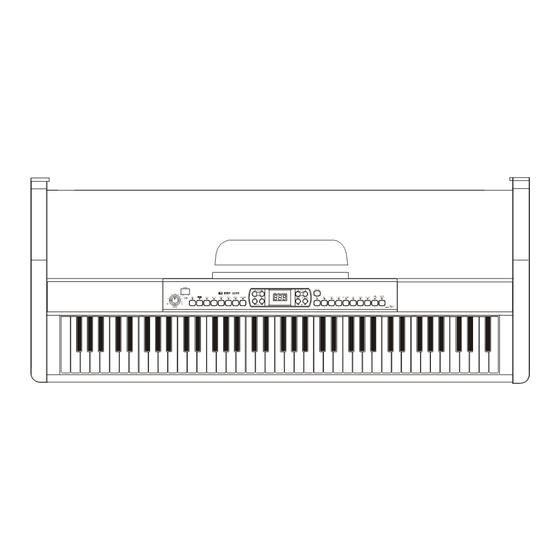
Table of Contents
Advertisement
Quick Links
Advertisement
Table of Contents

Summary of Contents for Princeton HP-11
- Page 1 User’s Manual Princeton HP-11 DIGITAL PIANO...
- Page 2 Using Your Instruction Manual Congratulations on the purchase of your new digital piano! With your new piano, you’ll enjoy breakthrough technology and advanced sound reproduction – bringing you professional performance and entertainment wrapped in one! This skillfully built digital piano enables you to explore your creativity, and helps make yours a more musical home…...
- Page 3 Precautions Please read the following carefully before use: Do not expose the piano to high temperature, direct sunlight or excessive dust. Do not place the piano too close to appliances such as televisions and radios as these items may cause interference.
-
Page 4: Table Of Contents
Contents Digital Piano Set-up Guide General Guide The Connectors - Using the AC power jack - Using Headphones - Using the MIDI OUT jack Operation 9-13 1. Power Switch & Volume 2. Voice/Dual Voice 3. Metronome 4. DSP (Digital Signal Processor) 5. -
Page 5: Digital Piano Set-Up Guide
Digital Piano Set-up Guide 1. Open the package, and check that you have the following parts: 1. Piano body 2. Music stand 3. Right leg 4. Left leg 5. Back panel 6. Foot pedal unit 7. Hand screw (4 pcs.) 8. - Page 6 Digital Piano Set-up Guide 2. Follow the illustration below to setup your piano. Put the foot pedal unit(6) in between the left and right legs (3&4) . Use 4 screws (2 on each side) to attach the legs onto the foot pedal unit. (Make sure the position correct before tightening screws) Use 4 screws (2 on each side) to tighten the back panel (5) onto the finished assembly in Part A.
- Page 7 Digital Piano Set-up Guide Put the piano body (1) on the top of the finished stand from part B. Use 4 hand screws to fasten the piano to the stand. Fasten the cable stabling hook(10) on the internal side of the legs (see the illustration below for reference).
-
Page 8: General Guide
General Guide Top View Rear View Front View Control Panel MIDI OUT Jack Headphones Jack Soft Pedal Sustain Pedal Piano Keyboard Music Stand... - Page 9 General Guide POWER SWITCH ) V OICE TYPE & DEMO SONG SELECT MASTER VOLUME 0 - PIANO 1 DUAL 1 - PIANO 2 2 - E.PIANO 1 TOUCH 3 - E.PIANO 2 RECORD 4 - HARPSICHORD TRACK A 5 - VIBES TRACK B 6 - STRINGS ENSEMBLE REPEAT...
-
Page 10: The Connectors
The Connectors Using the AC power jack Ensure the piano is turned off when connecting and disconnecting the power Plug the power cable into an AC power outlet. Turn the volume switch anti-clockwise to reach the minimum volume level. If you have done the above procedures, it is now safe to turn on the piano. -
Page 11: Operation
Operation 1. Power Switch & Volume Turn POWER switch The LED display lights up. 2. Use the volume control switch to adjust the volume to your desired level Caution: If the LED display has not lit up after you turned on the piano, please check the power supply. If the piano is silent, the volume may be adjusted to its minimum level. -
Page 12: Dsp (Digital Signal Processor)
4. DSP (Digital Signal Processor) Press the [DSP] button to turn on/off the DSP. The status will appear on the LED. 5. Transpose The Transpose function allows you to change the pitch of the instrument in semi-tone steps, up to a maximum setting of 12 semitones above or below standard pitch. -
Page 13: Touch Response
7. Touch Response Press the [TOUCH] button to adjust the touch response level in the range of 1 to 3. 2 is the default level. To turn off the touch response function, press the [TOUCH] button repeatedly until "OFF" appears on the display. 8. -
Page 14: Demo Song
Repeat the playback During the playback, press the [REPEAT] button to set the start point that you want to listen, "r-A" will appear on the display, then press the [REPEAT] button again to set the end point of the playback, "r-B" will appear on the display and the recorded song will playback repeatedly. -
Page 15: Foot Pedals
Repeat the demo song While a demo song is playing, press the [REPEAT] button to set the beginning point that you want to listen. "r-A" will appear on the display, then press the [REPEAT] button again point playback."r-B" will appear on the display and the selected section of the demo song will playback repeatedly. -
Page 16: Midi
MIDI The MIDI OUT terminal is located at the rear panel of the unit. The following shows the description of MIDI and the steps of using the MIDI function. What is MIDI? MIDI stands for Musical Instrument Digital Interface. MIDI is a world wide standard that makes it possible for various electronic musical instruments and other devices, such as computers, to "communicate with each other". -
Page 17: Specifications
Specifications Keyboard 88 hammer action keys Voice 10 Voices Demo Song 20 Demo Songs Display Switch and Buttons POWER SWITCH, VOLUME SWITCH, DUAL, DSP, TOUCH, RECORD, TRACK A, TRACK B, REPEAT, METRONOME, TRANSPOSE +/-, TEMPO +/-, DEMO ALL, RECORD - PLAY/STOP, DEMO - SELECT/ START/STOP, VOICE SELECT 0-9 Transpose 12 semi tones... -
Page 18: Voice List
Voice List Name of Voice Name of Voice on Panel Demo Song List...



Need help?
Do you have a question about the HP-11 and is the answer not in the manual?
Questions and answers